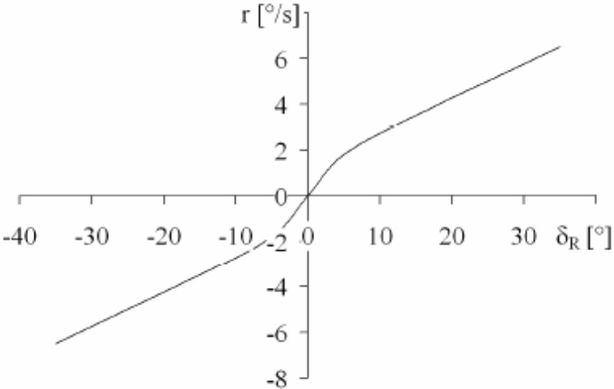Opis
The data show the results of the spiral test for the simplified ship model, taking into account two states of loading: ballast and full load. The data set contains the results of time simulation for sea state 10 on the Beaufort scale: changes in rudder angle delta_tab[deg]; angular velocity r_tab[deg/s]; surge velocity u_tab (m/s); sway velocity v_tab (m/s); surge position x_tab (m); sway position y_tab (m); course kurs_tab (deg); relative pitch of main propeller Hs_tab (-); initial propeller speed ns_tab (in revolution per second).
The spiral test consists in performing an orderly sequence of circles by changing the rudder angle. According to the regulations of the Polish Register of Shipping (PRS), it starts from the rudder angle of 15º. After setting the constant angular velocity, the rudder angle is reduced initially every 5º, and then every 2º. When the direction of angular velocity changes, the test shall continue in the same way for negative rudder angle values as for positive ones. The results of the test shall be shown on the graph of the relationship between the angular velocity (𝑟) and the rudder angle (dR). If the 𝑟 chart intersects the origin, the vessel shall be stable, otherwise it shall show a lack of straight-line stability. The measure of instability is determined by the size of the instability loop (𝑙𝑟). The Polish Register of Shipping defines the spiral test as an additional test. It is recommended to carry out this test when the standard tests indicate dynamic instability or limit stability of the ship. It is very time-consuming, especially for large and slow vessels, and the results obtained are very dependent on the weather conditions during the test. After this test, detailed information on the instability, if any, is obtained. The resulting manuvering characteristics diagram is a component of the simplified ship mathematical model used for course control.


Basic technical parameters of the ship model: overall length 181(m), width 165(m). Ballast condition: draught at the bow 5.5(m), draught at the stern 6.7(m), displacement 16400(m3). In full load condition: draught at the bow 9.64(m), draught at the stern 9.64(m), displacement 28350(m3).
Plik z danymi badawczymi
hexmd5(md5(part1)+md5(part2)+...)-{parts_count} gdzie pojedyncza część pliku jest wielkości 512 MBPrzykładowy skrypt do wyliczenia:
https://github.com/antespi/s3md5
Informacje szczegółowe o pliku
- Licencja:
-
otwiera się w nowej karcie
CC BYUznanie autorstwa - Dane surowe:
- Dane zawarte w datasecie nie zostały w żaden sposób przetworzone.
- Oprogramowanie:
- Matlab
Informacje szczegółowe
- Rok publikacji:
- 2020
- Data zatwierdzenia:
- 2020-12-17
- Data wytworzenia:
- 2009
- Język danych badawczych:
- angielski
- Dyscypliny:
-
- Automatyka, elektronika i elektrotechnika (Dziedzina nauk inżynieryjno-technicznych)
- DOI:
- Identyfikator DOI 10.34808/85sr-s841 otwiera się w nowej karcie
- Weryfikacja:
- Politechnika Gdańska
Słowa kluczowe
Powiązane zasoby
- publikacja Nonlinear Backstepping Ship Course Controller
- publikacja Metoda backstepping w zastosowaniach morskich
- publikacja Designing a ship course controller by applying the adaptivebackstepping method
- dane badawcze Simulation of ship turning circle test for ballast and full load conditions
Cytuj jako
Autorzy
wyświetlono 370 razy

